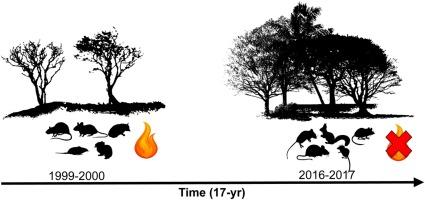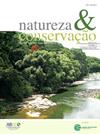由于长期缺乏自然火灾,巴西塞拉多保护区的小型哺乳动物种群结构发生了变化
IF 3.5
2区 环境科学与生态学
Q1 BIODIVERSITY CONSERVATION
引用次数: 0
摘要
自然火灾是一个重要的生态过程,几千年来塑造了大草原。局部哺乳动物群落结构受植被多样性和复杂性的影响,由于缺乏火灾导致的植被组成和结构的变化导致了小体哺乳动物群落的重组。考虑到这个问题对于理解塞拉多地区小体哺乳动物群落的长期重组至关重要,我们旨在评估小体哺乳动物群落对长时间(即17年)无火的反应。在我们在塞拉达斯阿拉拉斯生态站(SAES)的研究中,我们比较了2016-2017年(长时间没有火灾)采样的小型哺乳动物组合与1999-2000年进行的一项研究的样本,当时火灾已经自然发生。我们使用描述性统计和稀疏度来评估物种丰富度,并使用SIMPROF的非度量多维尺度(NMDS)对两个时期的哺乳动物组成进行特定地点的分析。我们的主要结果清楚地表明,2001年至2016年期间,与持续火灾期间(1995年至2000年)相比,SAES中没有自然火灾的小体哺乳动物动物群进行了重组。我们的研究结果表明,大多数物种在森林和草原环境中都是常见的,这反映了由于没有自然火灾而导致的栖息地同质化。根据我们的研究,我们可以得出结论,在巴西塞拉多一个重要的保护区,没有火灾已经部分地重组了小体哺乳动物的组合。考虑到火灾是塞拉多动态的一个关键因素- -塞拉多在历史上是在火灾驱动的过程中演变的- -鉴于火灾管理在维持(或消除)当地多样性方面的关键作用,特别是在拥有大量干燥生物质的情况下,需要进一步就火灾管理进行技术讨论。就保护而言,迄今为止的证据表明,大火无疑是灾难性的,但塞拉多原生地区缺乏自然火灾显然也损害了塞拉多易发生物。本文章由计算机程序翻译,如有差异,请以英文原文为准。

The long-term absence of natural fires restructures the small-bodied mammal assemblages across a Protected Area of Brazilian Cerrado
Natural fires are an important ecological process that over millennia have shaped savannahs. Local mammalian assemblage structure is influenced by vegetation diversity and complexity, whereby changes in composition and structure of vegetation due to fire absence lead to the reorganization of small-bodied mammal assemblages. We aimed to evaluate how small-bodied mammal assemblages respond to prolonged (i.e., 17 years) fire absence, given that this issue is crucial to understanding the long-term reassembling of small-bodied mammal assemblages in the Cerrado. In our study at Serra das Araras Ecological Station (SAES), we compared small-mammal assemblages sampled in 2016–2017 — during a prolonged period without fire — with those from a study conducted in 1999–2000, when fires had been occurring naturally. We used descriptive statistics, rarefaction to assess species richness, and Non-Metric Multidimensional Scaling (NMDS) with SIMPROF for site-specific analysis of mammal composition between both periods. Our major result showed clearly that the absence of natural fires during 2001–2016 in the SAES reassembled the small-bodied mammal fauna compared to the period with constant fires (1995–2000). Our findings indicate that most species are common to both forest and savannah environments, reflecting the homogenization of habitats due to the absence of natural fires. Based on our study, we can conclude that the absence of fire has partially reassembled the small-bodied mammal assemblages across an important protected area of Brazilian Cerrado. Considering that fire is a crucial factor for the dynamics of the Cerrado — which has evolved historically under fire-driven processes — further technical discussions about fire management are needed given its crucial role in maintaining (or erasing) aspects of local diversity, especially with high stocks of dry biomass. In terms of conservation, the evidence so far showed that big-fires are conclusively disastrous, but the absence of natural fires in native areas of Cerrado apparently also harmed the Cerrado-prone biotas.
求助全文
通过发布文献求助,成功后即可免费获取论文全文。
去求助
来源期刊

Perspectives in Ecology and Conservation
Environmental Science-Nature and Landscape Conservation
CiteScore
7.80
自引率
4.30%
发文量
46
审稿时长
59 days
期刊介绍:
Perspectives in Ecology and Conservation (PECON) is a scientific journal devoted to improving theoretical and conceptual aspects of conservation science. It has the main purpose of communicating new research and advances to different actors of society, including researchers, conservationists, practitioners, and policymakers. Perspectives in Ecology and Conservation publishes original papers on biodiversity conservation and restoration, on the main drivers affecting native ecosystems, and on nature’s benefits to people and human wellbeing. This scope includes studies on biodiversity patterns, the effects of habitat loss, fragmentation, biological invasion and climate change on biodiversity, conservation genetics, spatial conservation planning, ecosystem management, ecosystem services, sustainability and resilience of socio-ecological systems, conservation policy, among others.
 求助内容:
求助内容: 应助结果提醒方式:
应助结果提醒方式:


